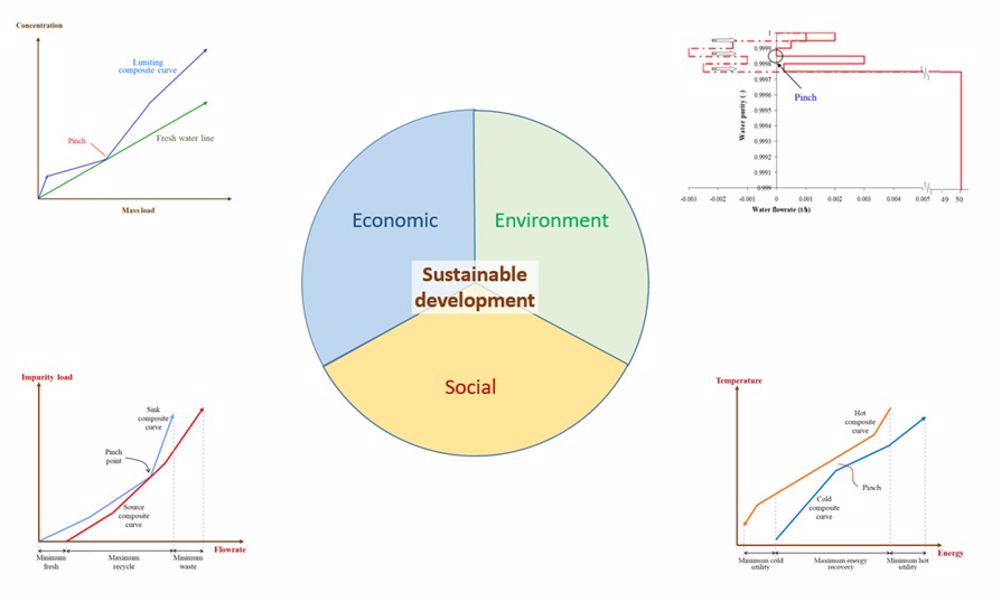Sustainable Process Design through Process Integration
A Systematic method for sustainable chemical process design was developed since 1970s. One of the widely recognised family of approaches is arguably process integration. The development of process integration techniques mainly focused on heat exchanger network synthesis back in 1970s, with the first user guide published by the IChemE (Linnhoff et al., 1982). In this earliest trend of process integration, heat exchanger network was designed to achieve the minimum hot and cold utility targets for a process plant. In the 1980s, process integration techniques were extended to systematic design of energy-intensive processes, such as distillation, dryers, etc. and were commonly found in main stream chemical process design textbooks (Smith, 2016; Seider et al., 2017). Doing process integration leads to reduced utility consumption, which translates to lower operating cost and CO2 emissions.
From the late 1980s till early 21st century, process integration techniques were extended for pollution prevention through mass exchanger network synthesis and mass integration (El-Halwagi, 2017). This allows the minimum use of mass separating agents such as adsorbents, solvents, etc., which translates to reduced waste discharge from the process plants. Some specialised cases of mass integration work are worth mentioning such as water and hydrogen integration. For the former, process integration techniques allows the minimum fresh water and wastewater flowrates to be identified after their recovery potential are maximised among various water-using processes in the plant. Similar principles were applied for hydrogen integration, where the recovery of waste hydrogen gases are maximise in order to reduce fresh hydrogen intake and reduced discharge streams. These lead to cleaner and more sustainable processes.

Two distinct approaches within the process integration family include pinch analysis and mathematical programming techniques. Both techniques have their respective advantages and limitations. Pinch analysis provides good insights for designers, but has limited capability in cost optimisation. In contrast, mathematical programming is able to overcome those limitations and to deal with complex cases, though it suffers from the lack of providing good insights for process designers. Hence, pinch analysis and mathematical programming techniques complement each other well in solving various industrial problems.
After four decades of development, process integration techniques are now relatively mature. A compilation of these techniques may be found in various chemical engineering design textbooks (Smith, 2016 and Foo, 2012; El-Halwagi, 2017), industrial guidebook (Klemeš, 2013), and encyclopaedia chapter (El-Halwagi and Foo, 2014). Besides, various commercial software packages are made available for use of industrial practitioners, e.g. Aspen Energy Analyzer (www.aspentech.com). Applications of process integration techniques for sustainable process design have been reported for various plants such as chemical, petrochemicals, petroleum refinery, pulp and paper mill, pulp and paper, textile, food and beverage, palm oil, bricks, sugar, etc. (Foo, 2012; Smith, 2016; El-Halwagi, 2017).
It is also worth noting that various new process integration techniques are being developed and reported in research journal and conferences. A dedicated research conference for process integration is held yearly (www.conferencepres.com), with its proceedings made available freely (https://www.aidic.it/cet/). Besides, a dedicated research journal dedicated to process integration were initiated in the past decade - https://link.springer.com/journal/41660. Process integration is also widely taught in university programmes and applied through design courses and the main design project worlwide.
Further readings:
El-Halwagi, M. M. (2017). Sustainable Design through Process Integration. Waltham, U.S.: Elsevier.
El-Halwagi, M. M. and Foo, D. C. Y. (2014). Process Synthesis and Integration, in Seidel, A. and Bickford, M. (Ed.). Kirk-Othmer Encyclopedia of Chemical Technology, John Wiley & Sons.
Foo, D. C. Y. (2012). Process Integration for Resource Conservation, CRC Press, Boca Raton, Florida, US.
Klemeš, J., (Ed.) Handbook of Process Integration (PI): Minimisation of Energy and Water Use, Waste and Emissions, Woodhead Publishing.
Linnhoff, B., Townsend, D. W., Boland, D., Hewitt, G. F., Thomas, B. E. A., Guy, A. R. and Marshall, R. H. 1982, 1994. A User Guide on Process Integration for the Efficient Use of Energy. Rugby: IChemE.
Majozi, T. (2010). Batch Chemical Process Integration: Analysis, Synthesis and Optimization, London: Springer.
Seider, W., Lewin, D., Seader, J., Widagdo, S., Gani, R. and Ng, K. (2017). Product and Process Design Principles. 4th ed. United States: Wiley.
Smith, R. (2016). Chemical Process: Design and Integration, 2nd Ed. West Sussex, England: John Wiley.